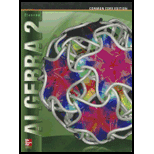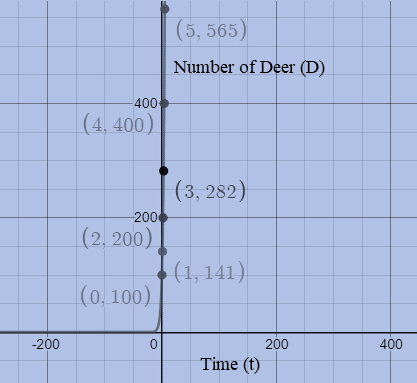
a.
The number of deer after
a.
Answer to Problem 52PPS
The number of deer after
Explanation of Solution
Given information: The number of Deer
Calculation: From (1) the number of deer after
b.
Draw a table that shows the population of deer every year for next five years.
b.
Answer to Problem 52PPS
| Time (t) | Number of Deer (D) |
| 0 | 100*20= 100 |
| 1 | 100*20.5 = 141 |
| 2 | 100*21= 200 |
| 3 | 100*21.5 = 282 |
| 4 | 100*22= 400 |
| 5 | 100*22.5 = 565 |
Explanation of Solution
Given information: The number of Deer
Calculation: From (1) the number of deer for the next five years can be evaluated by plugging
| Time (t) | Number of Deer (D) |
| 0 | 100*20= 100 |
| 1 | 100*20.5 = 141 |
| 2 | 100*21= 200 |
| 3 | 100*21.5 = 282 |
| 4 | 100*22= 400 |
| 5 | 100*22.5 = 565 |
c.
Show the graph for number of deer verses time with the help of table obtained.
c.
Explanation of Solution
Given information: The number of Deer
Graph: The graph for the number of deer verses the time is shown as,

d.
With the help of graph and table decide whether it is a reasonable trend over the long period. Explain.
d.
Answer to Problem 52PPS
No, it is not reasonable trend over the long period.
Explanation of Solution
Given information: The number of Deer
Calculation: From the table and graph of the number of deer verses the time it can be said that the number of deer grows rapidly. And as seen from the number of deer graph it can be observed that the deer grows rapidly in small interval of time and the graph line for the population of deer is approaching to y-axis. Therefore, for the long term period it is not reasonable to say anything about the trend because there are many factors like environment conditions, temperature and rate of death etc. which can affect the deer population for long term.
Chapter 6 Solutions
Glencoe Algebra 2 Student Edition C2014
Additional Math Textbook Solutions
Basic Business Statistics, Student Value Edition
College Algebra with Modeling & Visualization (5th Edition)
A First Course in Probability (10th Edition)
A Problem Solving Approach To Mathematics For Elementary School Teachers (13th Edition)
Introductory Statistics
University Calculus: Early Transcendentals (4th Edition)
- Please use the infinite series formula and specify how you did each step. Thank you.arrow_forward8) Solve the given system using the Gaussian Elimination process. 2x8y = 3 (-6x+24y = −6arrow_forward7) Solve the given system using the Gaussian Elimination process. (5x-4y = 34 (2x - 2y = 14arrow_forward
- 33 (a) (b) Let A(t) = = et 0 0 0 cos(t) sin(t) 0-sin(t) cos(t)) For any fixed tЄR, find det(A(t)). Show that the matrix A(t) is invertible for any tЄ R, and find the inverse (A(t))¹.arrow_forwardUse the infinite geometric sum to convert .258 (the 58 is recurring, so there is a bar over it) to a ratio of two integers. Please go over the full problem, specifying how you found r. Thank you.arrow_forwardH.w: Find the Eigen vectors for the largest Eigen value of the system X1+ +2x3=0 3x1-2x2+x3=0 4x1+ +3x3=0arrow_forward
- need help with 5 and 6 pleasearrow_forward1) Given matrix A below, answer the following questions: a) What is the order of the matrix? b) What is the element a13? c) What is the element a₁₁? 4 -1arrow_forward[25 points] Given the vector let v = ER² and the collection of vectors ε = E-{)·()}-{☹) (9)} = {(A)·(9)}· B: = and C = · {(6)·(})}· answer the following question. (a) (b) (c) (d) (e) verify Verify is a basis for R² and find the coordinate [] of under ε. Verify B is a basis for R2 and find the coordinate []B of ʊ Verify C is a basis for R2 and find the coordinate []c of under ε. under ε. Find the change-of-basis matrix [I]+B from basis B to basis ε, and EE+BUB Find the change-of-basis matrix [I]B+ε from basis Ɛ to basis B, and verify [U]B= [] B+EVEarrow_forward
- Explain the following terms | (a) linear span (b) dimension of vector space (c) linearly independent (d) linearly dependent (e) rank of matrix Aarrow_forward3. Let u = 3/5 √ = and = -4/5 -() Define V span{ū, }. (a) (b) (c) Show that {u, } is orthonormal and forms a basis for V. Explicitly compute Projy w. Explicitly give a non-zero vector in V+.arrow_forwardIs 1.1 0.65 -3.4 0.23 0.4 -0.44 a basis for R3? You must explain your answer 0arrow_forward
 Algebra and Trigonometry (6th Edition)AlgebraISBN:9780134463216Author:Robert F. BlitzerPublisher:PEARSON
Algebra and Trigonometry (6th Edition)AlgebraISBN:9780134463216Author:Robert F. BlitzerPublisher:PEARSON Contemporary Abstract AlgebraAlgebraISBN:9781305657960Author:Joseph GallianPublisher:Cengage Learning
Contemporary Abstract AlgebraAlgebraISBN:9781305657960Author:Joseph GallianPublisher:Cengage Learning Linear Algebra: A Modern IntroductionAlgebraISBN:9781285463247Author:David PoolePublisher:Cengage Learning
Linear Algebra: A Modern IntroductionAlgebraISBN:9781285463247Author:David PoolePublisher:Cengage Learning Algebra And Trigonometry (11th Edition)AlgebraISBN:9780135163078Author:Michael SullivanPublisher:PEARSON
Algebra And Trigonometry (11th Edition)AlgebraISBN:9780135163078Author:Michael SullivanPublisher:PEARSON Introduction to Linear Algebra, Fifth EditionAlgebraISBN:9780980232776Author:Gilbert StrangPublisher:Wellesley-Cambridge Press
Introduction to Linear Algebra, Fifth EditionAlgebraISBN:9780980232776Author:Gilbert StrangPublisher:Wellesley-Cambridge Press College Algebra (Collegiate Math)AlgebraISBN:9780077836344Author:Julie Miller, Donna GerkenPublisher:McGraw-Hill Education
College Algebra (Collegiate Math)AlgebraISBN:9780077836344Author:Julie Miller, Donna GerkenPublisher:McGraw-Hill Education





